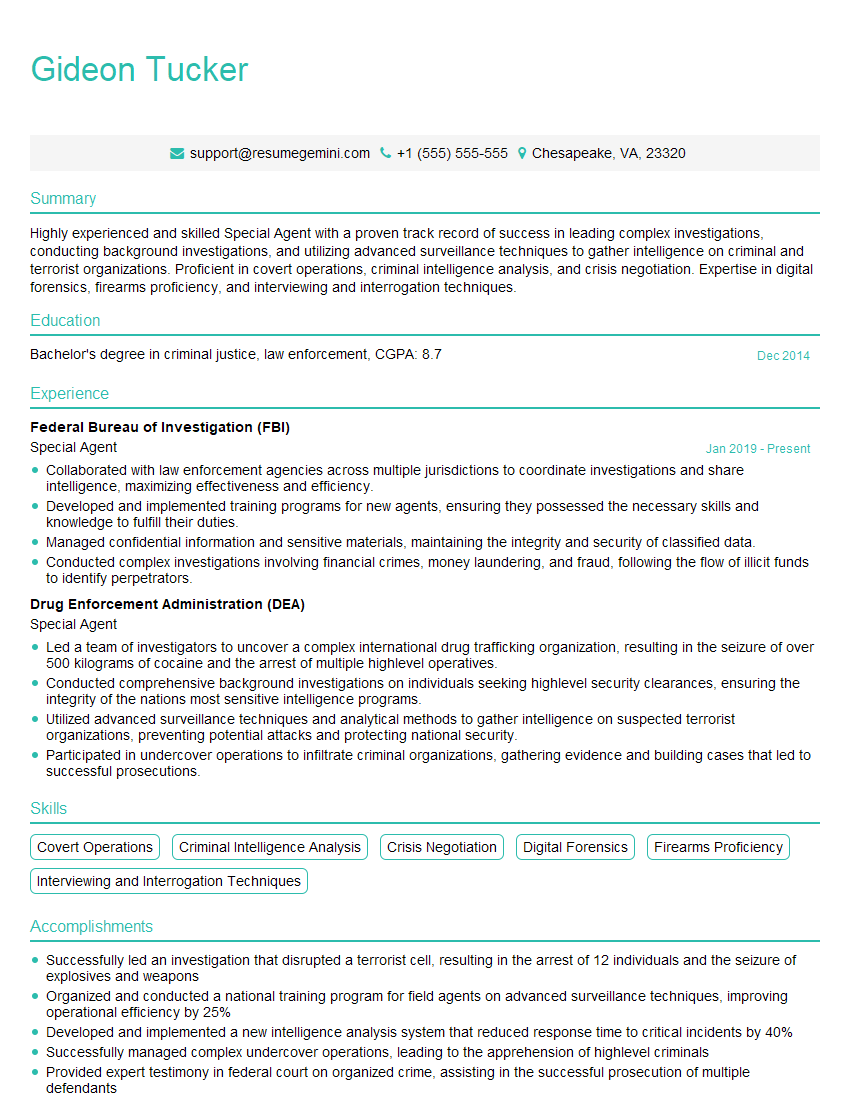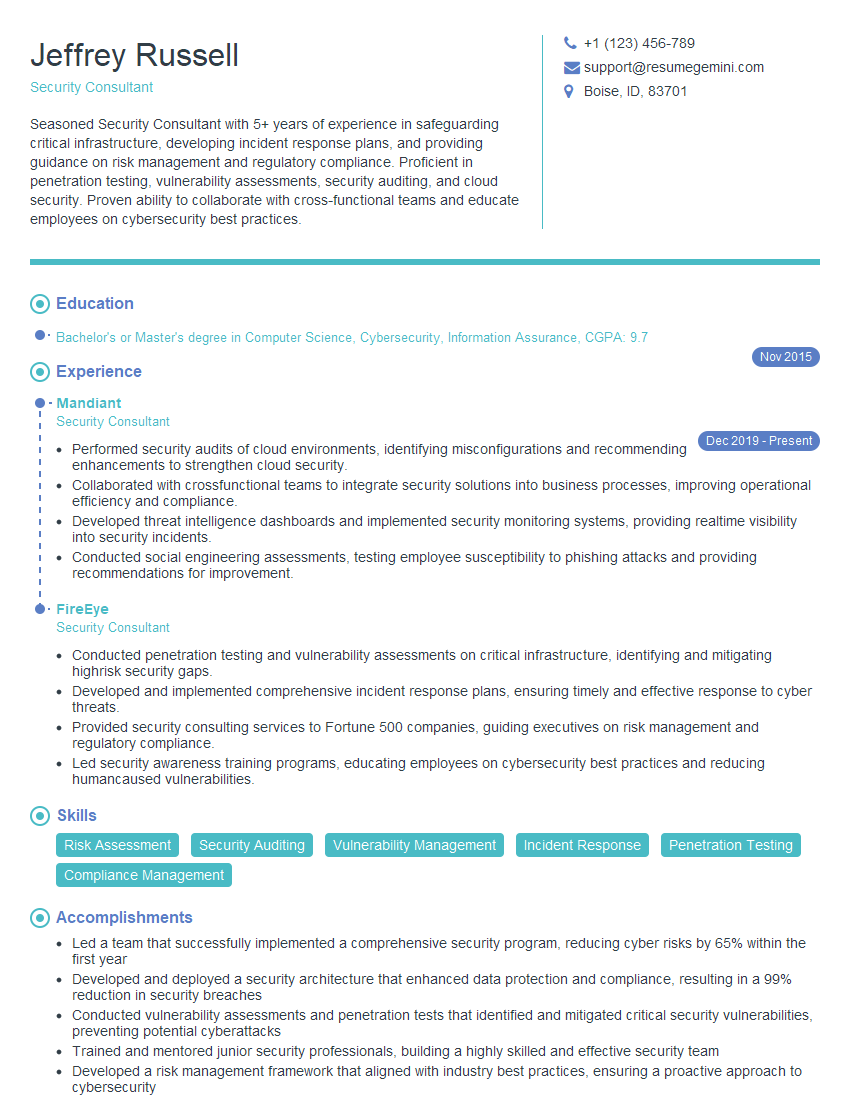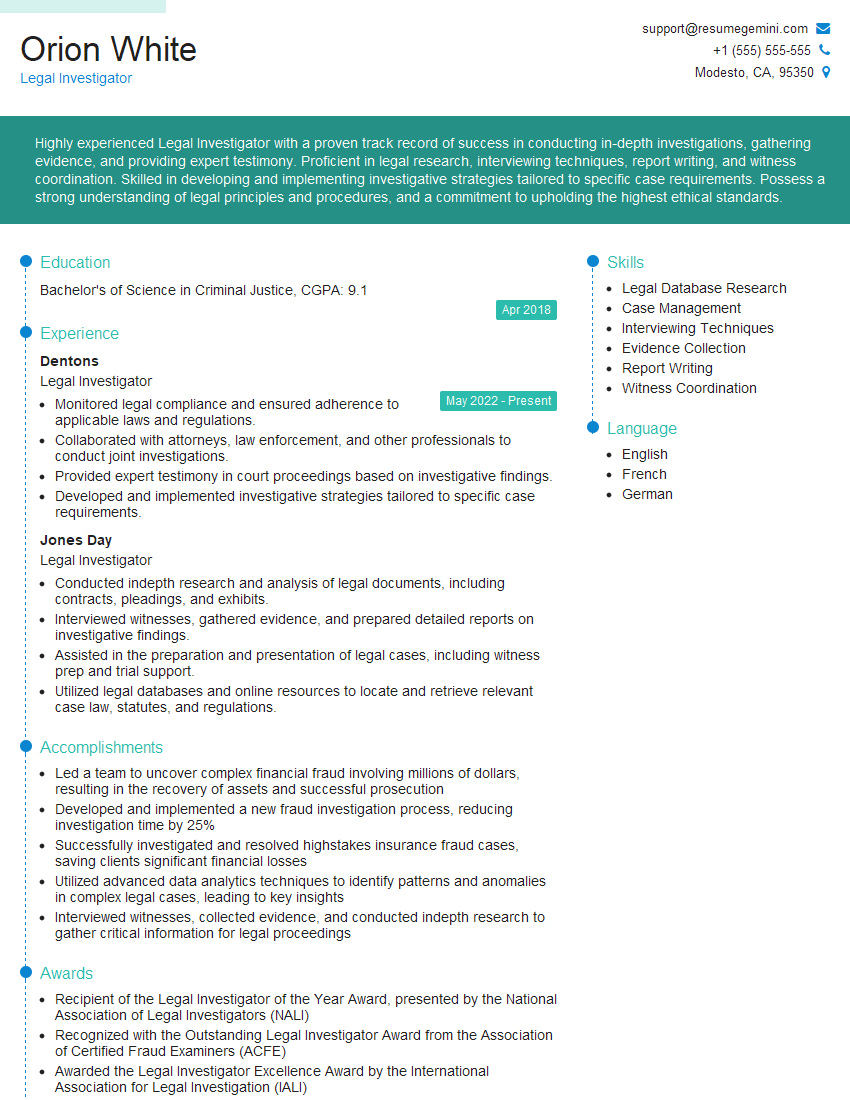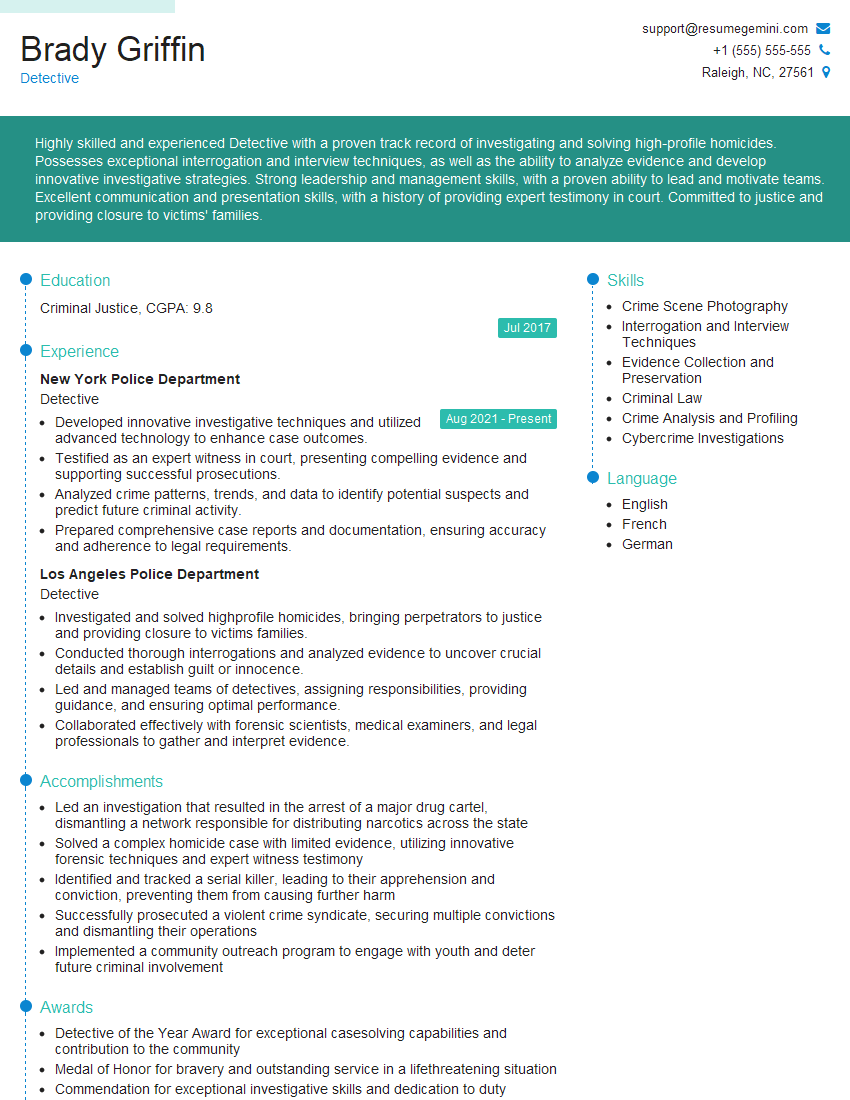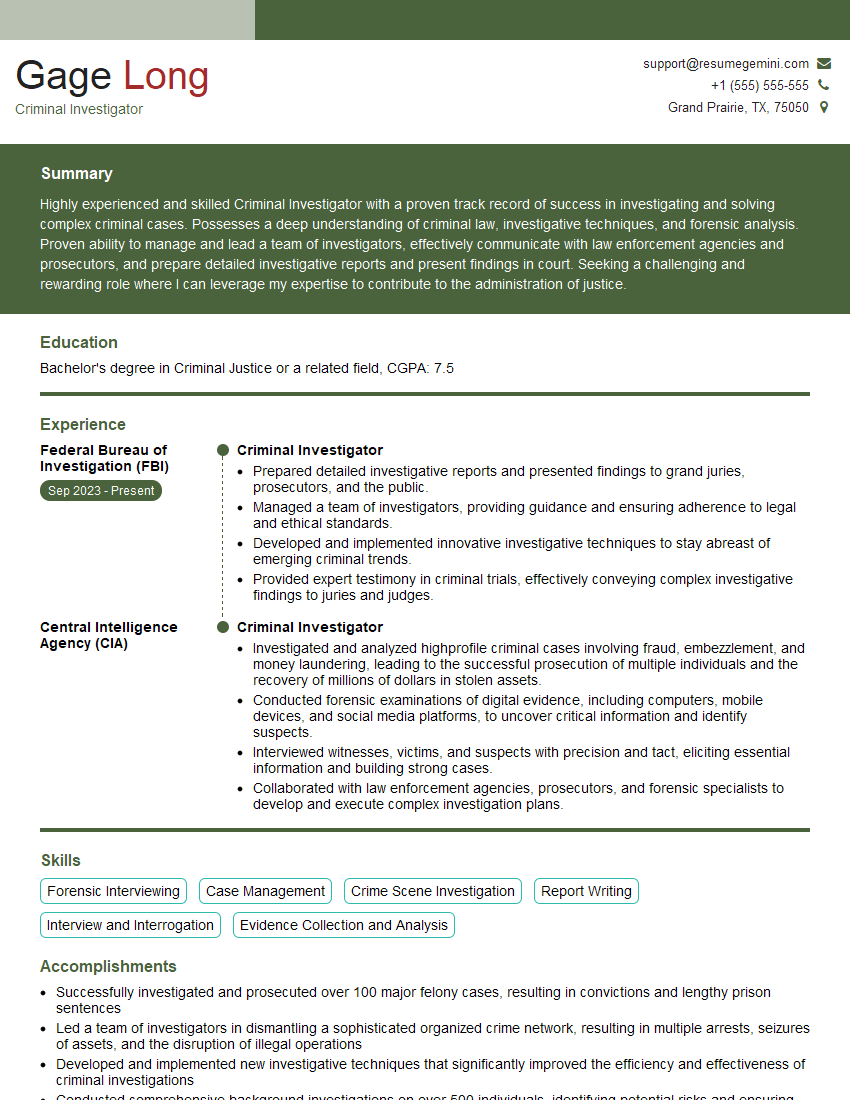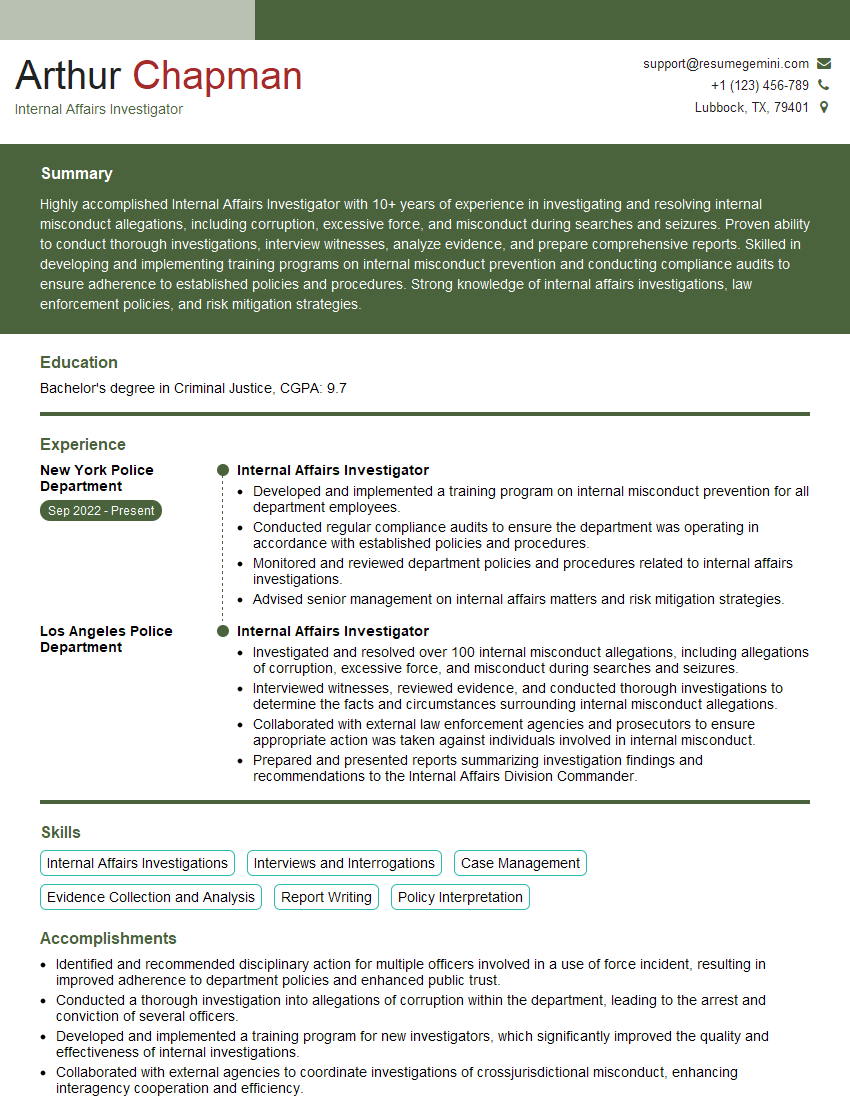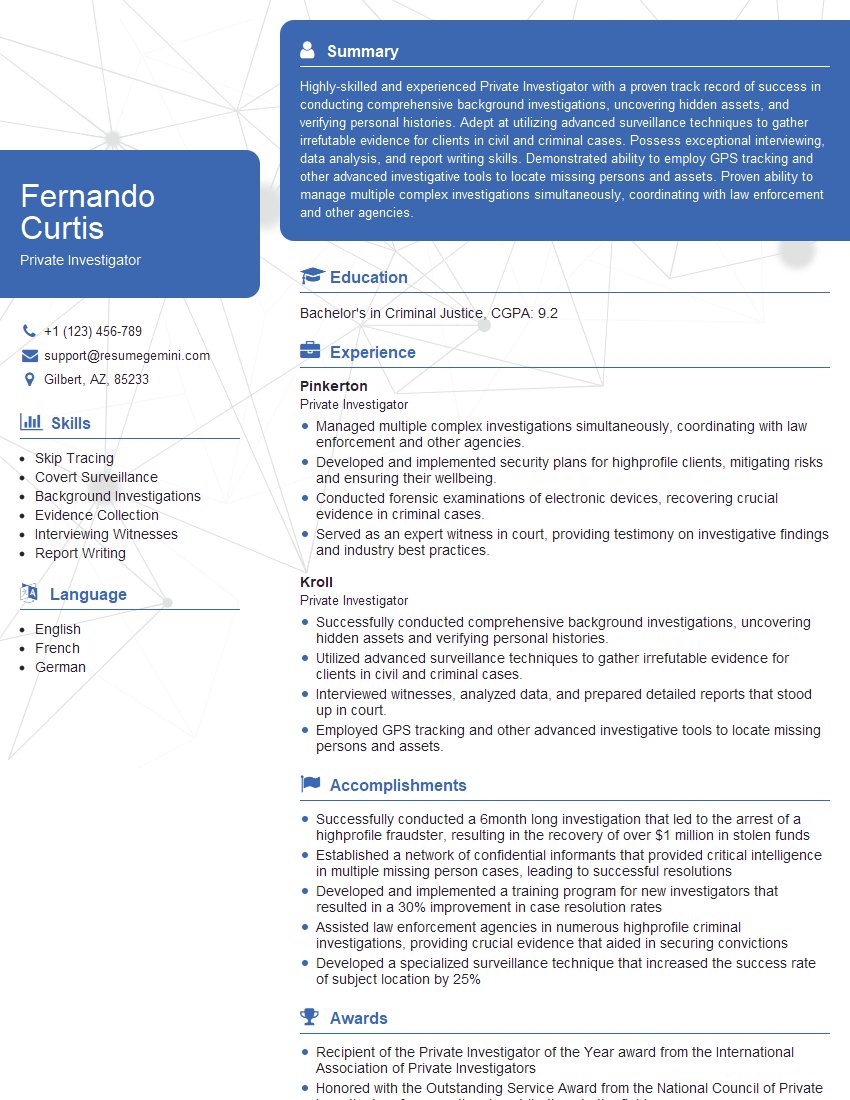Every successful interview starts with knowing what to expect. In this blog, we’ll take you through the top Interrogation and Interview Techniques interview questions, breaking them down with expert tips to help you deliver impactful answers. Step into your next interview fully prepared and ready to succeed.
Questions Asked in Interrogation and Interview Techniques Interview
Q 1. Describe the Reid Technique and its limitations.
The Reid Technique is a widely known interrogation method focusing on psychological manipulation to elicit confessions. It involves nine steps, starting with rapport building and progressing through accusations, theme development, and overcoming objections. The interviewer aims to create a sense of guilt and offer a face-saving explanation for the crime. However, it’s controversial due to its potential for false confessions.
- Limitations: Its coercive nature can lead innocent individuals to confess, especially vulnerable populations. The emphasis on deception and manipulation raises serious ethical concerns. The technique’s success heavily relies on the interrogator’s skill and experience, making it prone to bias and misinterpretation. Moreover, it doesn’t adequately address the cognitive biases that can influence both the interrogator and the suspect. It might not be effective with individuals who are psychologically resilient or those who firmly believe in their innocence.
- Example: Imagine an interrogation where a suspect, due to pressure and the interrogator’s suggestive questioning, confesses to a crime they didn’t commit, believing it’s the only way to escape the intense questioning.
Q 2. Explain the difference between an interview and an interrogation.
An interview is a conversational, non-accusatory process aimed at gathering information. It focuses on building rapport, actively listening, and asking open-ended questions. The goal is to obtain information, not a confession. In contrast, an interrogation is a highly structured, accusatory process aiming to obtain a confession. It typically involves the use of psychological tactics, and the interviewer’s goal is to secure an admission of guilt.
- Key Differences: The atmosphere is relaxed during an interview, whereas it’s intense and controlled during an interrogation. The questioning style differs significantly; interviews use open-ended questions, while interrogations may employ leading questions and psychological manipulation. The interviewer’s role also differs; in an interview, the interviewer acts as a neutral information gatherer, while in an interrogation, they play a more assertive role.
- Example: A police officer interviewing a witness at a crime scene uses open-ended questions and maintains a calm demeanor. However, when interrogating a suspect believed to be responsible for the crime, the same officer might use accusatory statements and psychological pressure to gain a confession.
Q 3. What are the ethical considerations in conducting interrogations?
Ethical considerations in interrogations are paramount. The primary concern is the avoidance of coercion and the protection of the subject’s rights. This includes ensuring the suspect understands their rights (e.g., right to an attorney, right to remain silent).
- Key Ethical Concerns: The use of deceptive tactics (lying about evidence), prolonged questioning without breaks, psychological manipulation (e.g., minimizing the severity of the crime), and physical coercion are all ethically problematic. The interrogator’s responsibility is to obtain truthful information without violating the subject’s rights or causing psychological harm. Maintaining a fair and impartial approach, documenting the interrogation meticulously, and ensuring that the confession is voluntary are critical ethical safeguards.
- Example: An interrogator falsely claiming to have forensic evidence that places the suspect at the crime scene is unethical. Similarly, keeping a suspect in an uncomfortable position for hours without breaks is a form of coercion and is ethically unacceptable.
Q 4. How do you build rapport with a subject during an interview?
Building rapport is crucial for a successful interview. It involves establishing trust and a comfortable atmosphere. It enables the subject to open up and provide accurate and complete information.
- Techniques: Active listening, showing empathy and understanding, using the subject’s name, and mirroring their body language can foster rapport. Mirroring involves subtly matching the subject’s posture or gestures to build a sense of connection. Starting the conversation with informal, non-threatening topics can help break the ice. Active listening includes demonstrating that you are paying attention through verbal and nonverbal cues such as nodding and summarizing the subject’s statements.
- Example: Beginning an interview with a friendly greeting, asking about the subject’s day, and allowing them to feel heard and respected before moving to the main subject matter can build trust.
Q 5. What nonverbal cues indicate deception?
Nonverbal cues suggesting deception aren’t conclusive on their own; however, clusters of behaviors might indicate potential deception. It’s crucial to consider the subject’s baseline behavior, as some individuals naturally display these behaviors.
- Common Cues: Avoidance of eye contact, fidgeting, excessive sweating, changes in speech patterns (hesitation, stammering), touching the face, and inconsistent body language can all be potential indicators of deception. However, these could also be signs of nervousness or stress, regardless of truthfulness.
- Important Note: A lack of any of these cues does not necessarily indicate truthfulness. Relying solely on nonverbal cues is unreliable. It should be combined with an analysis of the verbal content, consistency of responses, and overall context of the situation.
Q 6. Describe your approach to dealing with a hostile or uncooperative subject.
Handling a hostile or uncooperative subject requires patience, professionalism, and a strategic approach. The focus shifts from building rapport to controlling the interaction while still gathering information.
- Strategies: Maintaining composure, respecting the subject’s outburst (without allowing it to derail the interview), actively listening to understand their anger, refraining from engaging in arguments, and using calm, assertive communication are essential. Offering them a chance to explain their perspective can sometimes de-escalate the situation. If the hostility persists, it may be necessary to end the interview and reschedule it after a cool-down period.
- Example: If a suspect becomes aggressive, the interviewer might say something like, “I understand you’re upset, but we need to talk about this calmly.” It is often better to end the interview if the situation cannot be reasonably de-escalated for the safety of both the interviewer and the interviewee.
Q 7. How do you handle a subject who invokes their right to silence?
When a subject invokes their right to remain silent (Miranda rights), the interrogation must immediately cease. Continuing after this invocation is a violation of their rights and can compromise the admissibility of any subsequent statement.
- Procedure: The interviewer should respect the subject’s decision and document the invocation carefully. Any attempt to circumvent this right is legally and ethically unacceptable. While the interrogation halts, the interviewer may continue to observe the subject, but they cannot initiate further questioning or otherwise attempt to elicit a statement.
- Example: If a suspect clearly states, “I want a lawyer,” the questioning must end. Any further attempt at questioning would be a breach of protocol and may render any subsequent statements inadmissible in court.
Q 8. Explain the importance of documenting an interview or interrogation.
Documentation is paramount in interviews and interrogations. It provides a verifiable record of the interaction, protecting both the interviewer and the interviewee. A well-documented interview serves as irrefutable evidence in legal proceedings, protects against accusations of misconduct, ensures consistency in recalling details, and facilitates effective case management. Think of it as a detailed map of the conversation, crucial for navigating the complexities of a case.
- Legal Protection: Detailed notes safeguard against claims of coercion, bias, or misrepresentation.
- Accuracy & Recall: Memory is fallible. Detailed notes ensure consistent recollection of facts and statements.
- Case Building: Comprehensive documentation aids in building a solid case by highlighting inconsistencies, contradictions, or supporting evidence.
- Training & Review: Recorded interviews can be used for training purposes, identifying areas for improvement in questioning techniques.
For example, imagine an interview with a witness to a robbery. Thorough documentation of their account – including any hesitations, inconsistencies, and the witness’s emotional state – is critical. Without this documentation, their testimony might be dismissed as unreliable, even if it holds significant value.
Q 9. What are some common interrogation tactics?
Common interrogation tactics aim to elicit confessions or information from suspects. However, ethical considerations must always be paramount. Some tactics, while effective, can be legally problematic if not applied correctly. These methods should be used with caution and within the bounds of the law.
- Reid Technique (controversial): This involves accusatorial questioning, minimizing the suspect’s offense, and offering justifications or excuses for their actions. It’s often criticized for its potential to elicit false confessions.
- Good Cop/Bad Cop: One interrogator plays the harsh, unsympathetic role, while the other acts supportive and understanding. This creates a contrast that can manipulate the suspect into cooperating with the ‘good cop’.
- Minimization and Maximization: Minimizing the seriousness of the crime and maximizing the consequences of non-cooperation can pressure the suspect into confessing.
- False Evidence Ploys: Presenting false information about evidence (illegally, in many jurisdictions) to manipulate a confession – ethically dubious and often legally unacceptable.
- Interrogation Fatigue: Lengthy, tiring interrogations can break down a suspect’s resistance, making them more susceptible to suggesting information.
It’s crucial to understand that the ethical and legal ramifications of these tactics must always be carefully considered. The primary goal should always be to obtain truthful information, not to secure a confession at any cost.
Q 10. How do you adapt your questioning techniques to different personality types?
Adapting questioning techniques to different personality types is crucial for effective interviewing. Ignoring personality nuances can lead to misinterpretations and ineffective communication. Understanding how individuals process information and express themselves is key.
- Introverts vs. Extroverts: Introverts might need more time to respond and prefer structured, less demanding questioning. Extroverts might be more talkative and may require more guidance to focus on relevant information.
- Aggressive vs. Passive: Aggressive individuals might need a calm, controlled approach to de-escalate tensions. Passive individuals might require encouragement and prompting to elaborate.
- Emotional vs. Logical: Emotional individuals respond better to empathetic listening and understanding their feelings. Logical individuals may prefer structured questioning and factual information.
Consider this scenario: An interview with a highly emotional witness after a traumatic event. A structured, rapid-fire approach will likely cause further stress and hinder information gathering. Instead, building rapport, showing empathy, and allowing the witness to share their experiences in their own time is more productive.
Q 11. What is the PEACE model of interviewing, and how does it differ from traditional interrogation methods?
The PEACE model (Planning and Preparation, Engage and Explain, Account, Closure, Evaluation) is a modern interviewing approach that contrasts sharply with traditional interrogation methods. It focuses on building rapport, creating a safe space for information sharing, and avoiding coercive tactics.
- Planning & Preparation: Thorough research and preparation are key. Understanding the context, reviewing available information, and outlining a strategy are crucial.
- Engage & Explain: Building rapport with the interviewee is paramount, making them comfortable and building trust. The purpose and process of the interview should be clearly explained.
- Account: The interviewee is encouraged to provide their account freely and uninterrupted, creating a narrative flow.
- Closure: The interview concludes with summarizing key points, answering any questions, and ensuring the interviewee feels heard and respected.
- Evaluation: A post-interview review assesses the effectiveness of the approach, identifies areas for improvement, and evaluates the credibility of the information obtained.
Traditional interrogation often employs accusatorial questioning, pressure tactics, and deception, which can compromise the accuracy and reliability of the information obtained. PEACE, on the other hand, promotes collaboration and minimizes the risk of false confessions or unreliable statements.
Q 12. How do you assess the credibility of a witness’s statement?
Assessing the credibility of a witness’s statement involves a multifaceted approach, going beyond simply believing or disbelieving. It’s about evaluating the reliability and accuracy of the information provided.
- Consistency: Are the statements consistent across multiple interviews and with other evidence?
- Accuracy of Details: Does the witness provide specific details that are verifiable? Are there inconsistencies in minor details?
- Memory: Consider the witness’s memory limitations and potential biases introduced by time elapsed or emotional stress.
- Demeanor: While not conclusive, demeanor can provide clues – is the witness evasive, nervous, or overly confident?
- Motivation: What are the witness’s potential motivations for providing truthful or false information?
- Independent Corroboration: Does the witness’s statement align with other evidence or testimonies?
For example, a witness who provides detailed and consistent descriptions of a suspect that aligns with CCTV footage is considered more credible than one offering vague recollections with noticeable inconsistencies.
Q 13. What are some common cognitive biases that can affect the accuracy of an interview?
Cognitive biases can significantly impact the accuracy of interviews. These are systematic errors in thinking that can lead to inaccurate perceptions and judgments.
- Confirmation Bias: The tendency to seek out and interpret information that confirms pre-existing beliefs, ignoring contradictory evidence.
- Anchoring Bias: Over-reliance on the first piece of information received, influencing subsequent judgments.
- Availability Heuristic: Overestimating the likelihood of events that are easily recalled, often due to their vividness or recency.
- Framing Effect: How information is presented can influence interpretation and decisions.
Imagine an investigator who suspects a particular individual is guilty. Confirmation bias might lead them to interpret ambiguous statements as evidence of guilt, while ignoring exculpatory information. Awareness of these biases is crucial for conducting objective and fair interviews.
Q 14. How do you handle conflicting statements from multiple witnesses?
Handling conflicting statements from multiple witnesses requires careful analysis and consideration. It’s crucial to avoid jumping to conclusions and to investigate each account thoroughly.
- Identify Discrepancies: Carefully note the specific points of conflict between witness accounts.
- Re-interview Witnesses: Conduct further interviews to clarify inconsistencies, addressing specific points of conflict.
- Analyze Witness Reliability: Assess the credibility and reliability of each witness, considering factors such as memory, potential bias, and observational capabilities.
- Consider External Evidence: Examine physical evidence, CCTV footage, and other corroborating evidence to determine which account is more consistent with the facts.
- Reconstruct the Events: Try to construct a timeline of events based on the available information, considering possible explanations for the discrepancies.
For example, if two witnesses provide different descriptions of the perpetrator’s height, investigators must consider factors such as lighting conditions, distance from the event, and each witness’s individual biases. It might be that one witness has better eyesight or was closer to the event.
Q 15. How do you maintain objectivity during an interview or interrogation?
Maintaining objectivity during an interview or interrogation is paramount to obtaining accurate and reliable information. It requires a conscious effort to separate personal biases, preconceived notions, and emotional responses from the factual information being gathered. Think of it like being a scientist conducting an experiment – you need to remain neutral and objective to obtain valid results.
- Active Listening: Focus entirely on what the subject is saying, rather than formulating your next question or jumping to conclusions.
- Neutral Body Language: Maintain a calm and neutral demeanor. Avoid displaying expressions of judgment, surprise, or disbelief.
- Structured Questioning: Use open-ended questions that encourage the subject to provide detailed information, rather than leading questions that suggest a particular answer. For example, instead of asking ‘Did you steal the money?’, ask ‘Can you describe your actions on the day of the theft?’.
- Regular Self-Reflection: Regularly assess your own thoughts and feelings throughout the interview to identify any potential biases that might be influencing your perception or questioning technique.
- Documentation: Meticulously document everything, including your own observations and reactions, to ensure a transparent and auditable record.
For instance, if I am interviewing someone suspected of a crime, I would consciously avoid making assumptions based on their appearance or background. I would focus on the facts presented and gather evidence to support or refute those claims objectively.
Career Expert Tips:
- Ace those interviews! Prepare effectively by reviewing the Top 50 Most Common Interview Questions on ResumeGemini.
- Navigate your job search with confidence! Explore a wide range of Career Tips on ResumeGemini. Learn about common challenges and recommendations to overcome them.
- Craft the perfect resume! Master the Art of Resume Writing with ResumeGemini’s guide. Showcase your unique qualifications and achievements effectively.
- Don’t miss out on holiday savings! Build your dream resume with ResumeGemini’s ATS optimized templates.
Q 16. Describe your experience with forensic interviewing techniques.
My experience with forensic interviewing techniques spans over a decade, encompassing a wide range of cases including child abuse, fraud, and homicide investigations. Forensic interviewing is far more than just asking questions; it’s about building rapport, understanding the interviewee’s cognitive processes, and meticulously documenting everything.
- Rapport Building: I employ techniques such as mirroring body language (subtly), using empathetic language, and active listening to create a safe and trusting environment, particularly crucial when dealing with vulnerable witnesses or victims.
- Structured Interview Protocols: I regularly utilize structured protocols such as the NICHD protocol (National Institute of Child Health and Human Development) for interviewing children, which focuses on open-ended questions and avoids suggestive questioning.
- Statement Analysis: I’m proficient in analyzing written and verbal statements for inconsistencies, omissions, and deception cues. This includes attention to word choice, sentence structure, and body language.
- Memory Recall Techniques: I understand how memory works and utilize cognitive interviewing techniques (discussed later) to help witnesses recall details more accurately. I find that changing the order of questioning or focusing on different sensory details can often unlock new information.
In one particularly challenging case involving a child witness, the NICHD protocol was instrumental in eliciting critical details without pressuring or leading the child. The structured approach helped to ensure the interview was both thorough and trauma-informed.
Q 17. What steps do you take to ensure the admissibility of evidence obtained during an interview?
Ensuring the admissibility of evidence obtained during an interview is crucial. Inadmissible evidence can severely impact a case, leading to dismissal or acquittals. Therefore, I meticulously follow legal procedures and best practices:
- Miranda Rights (or equivalent): If the interview is conducted with a suspect in a custodial setting, ensuring they understand and waive their Miranda rights (or equivalent) is paramount. This includes the right to remain silent, the right to an attorney, and the understanding that anything said can be used against them.
- Recording the Interview: All interviews, especially those with suspects, are audio and video recorded. This creates an irrefutable record of what transpired.
- Chain of Custody: Maintaining a clear chain of custody for any physical evidence obtained during or resulting from the interview is vital for ensuring its authenticity and integrity.
- Avoid Coercion: Absolutely no coercion, threats, or promises are ever employed to obtain information. This would render any statement inadmissible.
- Documentation of Consent: Written consent is obtained whenever appropriate, particularly when dealing with vulnerable individuals.
In essence, the process aims to leave no room for doubt regarding the legality and validity of the evidence obtained, ensuring the interview complies with legal standards and upholds the rights of the interviewee.
Q 18. How do you handle sensitive or emotionally charged topics during an interview?
Handling sensitive or emotionally charged topics demands empathy, patience, and a carefully considered approach. The goal is to elicit information without retraumatizing the interviewee or compromising the integrity of the investigation.
- Empathy and Validation: I begin by acknowledging the emotional weight of the topic. Simple statements like, ‘This must be very difficult to talk about,’ can create a safe space.
- Control and Pace: I allow the interviewee to set the pace, offering breaks as needed. I avoid pressing too hard if they seem overwhelmed or distressed.
- Open-Ended Questions: I utilize open-ended questions to allow the interviewee to express themselves freely, rather than leading or pressuring them.
- Active Listening: I concentrate on active listening, showing genuine interest and validating their feelings.
- Professional Boundaries: While showing empathy is important, maintaining professional boundaries is crucial. I avoid becoming overly involved or offering personal opinions.
In interviews involving victims of abuse, for example, establishing rapport and providing a sense of control can make a significant difference in their willingness to share details. Providing regular breaks and validating their experience can help to mitigate trauma and ensure a more effective interview.
Q 19. Explain the concept of ‘cognitive interviewing’.
Cognitive interviewing is a technique designed to enhance the accuracy and completeness of witness recall by tapping into various cognitive processes and memory retrieval methods. It moves beyond standard questioning techniques and seeks to recreate the context surrounding the event.
- Context Reconstruction: This involves guiding the witness back to the scene of the event, asking them to reconstruct the setting, their emotional state, and sensory details (sights, sounds, smells, etc.).
- Multiple Retrieval Paths: It encourages recalling the event from different perspectives and sequences. Instead of chronological order, the interview might focus on specific details or objects.
- Report Everything: The witness is encouraged to report every detail, even if it seems insignificant or incomplete. Often, seemingly unimportant fragments can trigger additional memories.
- Change of Perspective: The interviewee might be asked to describe the event from another person’s perspective or imagine themselves as a different character in the scene.
Imagine a witness to a robbery. Cognitive interviewing might involve asking them to describe the scene from the perspective of the cashier, then from their own perspective, and finally, to list everything they saw, regardless of how trivial it might seem. This method often unlocks crucial details missed by more traditional approaches.
Q 20. What are the legal implications of using coercion during an interrogation?
The legal implications of using coercion during an interrogation are severe. Coerced confessions are inadmissible in court and can lead to serious consequences for the interrogator and the investigating agency.
- Violation of Rights: Coercion violates the fundamental rights of the suspect, including the right to remain silent and the right to legal counsel.
- Inadmissibility of Evidence: Any confession obtained through coercion is considered involuntary and will be excluded as evidence in a court of law. This can severely weaken or even destroy a prosecution’s case.
- Legal Sanctions: Depending on the jurisdiction and the severity of the coercion, the interrogator might face disciplinary action, criminal charges, or civil lawsuits.
- Damage to Credibility: The use of coercion damages the credibility of the investigation and undermines public trust in law enforcement.
Coercion includes physical violence, threats of violence, prolonged sleep deprivation, psychological manipulation, or any tactic designed to break the suspect’s will. The use of such tactics is unacceptable and unethical.
Q 21. How do you identify and address potential biases in your own interviewing practices?
Identifying and addressing potential biases in my own interviewing practices is an ongoing process that demands constant self-awareness and critical reflection.
- Awareness of Implicit Biases: I’m mindful of the impact of unconscious biases related to race, gender, age, socioeconomic status, and other factors. I actively seek to mitigate their influence on my questioning and interpretation of responses.
- Structured Protocols: Using standardized interviewing protocols, like those mentioned earlier, helps to minimize bias by providing a consistent framework for questioning.
- Peer Review: I regularly seek feedback from colleagues and supervisors on my interviewing techniques, focusing particularly on identifying any potential biases in my approach.
- Self-Reflection: After each interview, I engage in self-reflection, analyzing my performance and identifying areas where bias might have crept in. This includes reviewing recordings of my interviews.
- Training and Continuing Education: I actively participate in training and continuing education programs that address issues of bias in interviewing and interrogation.
For example, regularly reviewing recordings of my interviews helps me identify if I’ve inadvertently exhibited body language or tone that might communicate bias. Continuous learning and self-reflection are key to minimizing the impact of personal biases on the interview process.
Q 22. What are your strategies for dealing with resistance during an interview?
Resistance during an interview is common and can manifest in various ways, from outright denial to subtle evasion. My strategy focuses on building rapport, understanding the root of the resistance, and adjusting my approach accordingly. I start by acknowledging the individual’s feelings and concerns. For example, if someone is visibly angry, I might say something like, “I understand this is a difficult situation, and I appreciate you taking the time to talk to me.” This validation often helps to de-escalate the tension.
Next, I carefully assess the source of the resistance. Is it fear, distrust, anger, or something else? Once I identify the underlying cause, I can tailor my communication style and techniques. If it’s fear, I focus on reassurance and transparency. If it’s distrust, I emphasize the importance of honesty and fairness. For example, I might say, “I’m here to understand what happened, not to judge you.” I might also offer a break or a change of setting to make them more comfortable.
Finally, I employ techniques like active listening, empathetic questioning, and strategic silence to encourage cooperation. Sometimes, simply giving the individual space to express their feelings can lead to breakthroughs. If resistance persists, I might adjust my questioning strategy, using open-ended questions rather than leading ones. I also carefully document any instances of resistance for consideration of future interview techniques.
Q 23. How do you determine the best approach to interviewing a suspect based on their demeanor and behavior?
Determining the best approach hinges on a careful observation and assessment of the suspect’s demeanor and behavior. Body language, verbal cues, and overall presentation provide vital clues. A nervous suspect might fidget, avoid eye contact, and speak hesitantly. An aggressive suspect might be confrontational, interrupt frequently, and exhibit hostile body language. A deceptive suspect might exhibit microexpressions, inconsistencies in their story, and excessive detail or vagueness.
Based on this initial assessment, I adjust my interview style. With a nervous suspect, I aim to create a calm, reassuring environment, using a gentler, more empathetic approach. With an aggressive suspect, I maintain a calm and controlled demeanor, firmly establishing boundaries while ensuring the interview remains respectful and professional. For a deceptive suspect, I employ techniques like strategic questioning, carefully noting inconsistencies and challenging evasiveness. This may involve revisiting previous statements, presenting contradictory evidence, or using the Reid Technique elements, such as rapport building and the minimization of their actions while simultaneously maximizing the gravity of the crime.
It’s crucial to remember that these are general guidelines. Each interview is unique, requiring flexibility and adaptation. Successful interviewing relies on keen observation, intuition, and a deep understanding of human behavior.
Q 24. How do you verify the information gathered during an interview?
Verifying information is paramount. My approach involves a multi-faceted strategy, employing both direct and indirect methods. Direct verification involves confirming facts independently through various sources – this could be reviewing physical evidence, corroborating with witnesses, checking records (financial, medical, employment, etc.), or comparing against information obtained from alternative sources.
Indirect verification focuses on assessing the consistency and credibility of the interviewee’s statements. I look for inconsistencies in their narrative, compare their account against known facts, and assess their overall demeanor for signs of deception. I might use techniques such as the ‘known fact’ approach (introducing a known fact to gauge the reaction) or probing for details that might be difficult to fabricate.
For example, if a suspect claims to have been at a specific location at a particular time, I would verify this by checking security camera footage, interviewing potential witnesses, or examining any relevant records. The goal is to build a comprehensive picture of the events by cross-referencing information from various sources, allowing me to identify any discrepancies and strengthen or weaken the credibility of the information gathered.
Q 25. Explain the importance of active listening in interviewing.
Active listening is the cornerstone of effective interviewing. It’s more than just hearing words; it’s about understanding the meaning behind them, both verbal and nonverbal. It involves paying close attention to the interviewee’s verbal and nonverbal cues, such as their tone of voice, body language, and facial expressions. It also includes reflecting back what you’ve heard to ensure accurate understanding.
Active listening builds rapport, fostering trust and encouraging open communication. By demonstrating genuine interest and understanding, I can elicit more complete and accurate information. Techniques include maintaining eye contact (without being intimidating), nodding to show acknowledgement, summarizing key points, and asking clarifying questions. For example, instead of simply saying “Okay,” after a statement, I might say, “So, if I understand correctly, you’re saying…” This shows the interviewee that I’m paying attention and actively processing their information.
In short, active listening ensures that the interviewer and the interviewee are on the same page, creating a collaborative environment where the truth is more likely to emerge.
Q 26. Describe your experience with using technology to enhance interviews (e.g., recording devices, body cameras).
Technology has significantly enhanced the effectiveness of interviews and interrogations. I have extensive experience using recording devices (audio and video) and body cameras. Recording devices create a verifiable record of the interview, minimizing the possibility of disputes regarding what was said. This transparency is crucial for maintaining accountability and ensuring fairness.
Body cameras offer an additional layer of protection for both the interviewer and the interviewee. They provide a visual record of the interview setting and the interactions between the parties, reducing the risk of allegations of misconduct. In addition, I’m familiar with the use of software that enhances audio/visual recordings (noise cancellation, transcription software) to improve clarity and accessibility of the interview materials.
However, I am very mindful of the ethical and legal implications of using technology. I always ensure that recordings are made ethically and legally. This includes properly informing the interviewee that they are being recorded, obtaining consent where necessary, and adhering to all relevant privacy regulations. The data is stored securely, following all legal and agency guidelines.
Q 27. What is your experience with conducting interviews with vulnerable populations (e.g., children, elderly)?
Interviewing vulnerable populations requires specialized skills and sensitivity. My experience includes working with children and the elderly. These populations often require a different approach than interviewing adults, one that prioritizes their safety, comfort, and well-being. With children, I am trained in techniques suitable for their age and developmental level. This might involve using simple language, employing visual aids, and creating a relaxed, non-threatening environment.
I always prioritize building rapport by taking my cues from the child’s responses, ensuring they feel safe, and avoiding leading questions. Maintaining a safe and welcoming environment is key, as well as creating a trust-based environment before probing difficult issues. It is crucial to work closely with child protection services and other specialists, as needed.
With the elderly, the challenges might include cognitive impairments, physical limitations, or emotional fragility. Patience and empathy are essential. I adjust my questioning to their capabilities, allowing ample time for responses and ensuring that they understand the questions clearly. I am particularly mindful of their physical comfort and ensure they are in an appropriately supportive environment. In both cases, documenting the interview process is crucial, including any observed physical, emotional, and cognitive vulnerabilities of the interviewee.
Q 28. How do you manage the time constraints and pressure of an interview or interrogation?
Managing time constraints and pressure in interviews and interrogations is a critical skill. Effective time management begins with careful planning. Before the interview, I develop a clear outline of the key information I need to gather and prioritize the questions accordingly. I also allocate specific timeframes for different stages of the interview. This helps to maintain focus and ensures that all essential information is addressed within the available time.
During the interview, I employ techniques to keep the conversation focused and productive. This might involve gently redirecting the interviewee when they digress, summarizing key points to confirm understanding, and strategically using open-ended and closed-ended questions to efficiently gather information.
If time constraints become an issue, I might need to prioritize the most crucial information, knowing that a shorter interview may yield less comprehensive information. In such situations, I explicitly communicate the time constraints to the interviewee in a way that fosters collaboration instead of tension. In cases of extreme time pressure, I may need to curtail some areas of questioning and prioritize more critical aspects. It’s always important to ensure the integrity and fairness of the process are maintained, even under pressure.
Key Topics to Learn for Interrogation and Interview Techniques Interview
- Active Listening and Observation: Mastering techniques to fully understand verbal and nonverbal cues during interviews and interrogations. Practical application includes identifying inconsistencies and deception through careful observation.
- Questioning Techniques: Developing a strategic approach to questioning, including open-ended, closed-ended, and leading questions. Practical application involves tailoring questioning styles to different interview contexts and personality types.
- Rapport Building: Establishing trust and understanding with interviewees to encourage open communication and elicit accurate information. Practical application involves adapting communication styles to build rapport with diverse individuals.
- Interview Structure and Control: Understanding how to effectively structure an interview to gather necessary information efficiently and professionally. Practical application includes managing difficult interviewees and maintaining control of the interview process.
- Legal and Ethical Considerations: Understanding the legal and ethical boundaries of interrogation and interview techniques, ensuring compliance with relevant regulations and maintaining professional integrity. Practical application involves recognizing and addressing potential ethical dilemmas in real-world scenarios.
- Nonverbal Communication Analysis: Identifying and interpreting nonverbal cues to enhance understanding and assess credibility. Practical application includes recognizing microexpressions, body language, and vocal tone changes.
- Report Writing and Documentation: Developing clear, concise, and accurate reports that effectively document interview findings and conclusions. Practical application includes organizing and presenting findings in a format suitable for legal or investigative purposes.
Next Steps
Mastering Interrogation and Interview Techniques is crucial for career advancement in law enforcement, security, human resources, and investigative fields. A strong foundation in these techniques demonstrates valuable skills to potential employers and significantly increases your job prospects. To help you showcase your expertise, create an ATS-friendly resume that highlights your abilities effectively. ResumeGemini is a trusted resource to help you build a professional resume that catches the eye of recruiters. We provide examples of resumes tailored to Interrogation and Interview Techniques to give you a head start. Invest time in crafting a compelling resume – it’s your first impression and a key to unlocking your career aspirations.
Explore more articles
Users Rating of Our Blogs
Share Your Experience
We value your feedback! Please rate our content and share your thoughts (optional).
What Readers Say About Our Blog
Interesting Article, I liked the depth of knowledge you’ve shared.
Helpful, thanks for sharing.
Hi, I represent a social media marketing agency and liked your blog
Hi, I represent an SEO company that specialises in getting you AI citations and higher rankings on Google. I’d like to offer you a 100% free SEO audit for your website. Would you be interested?


